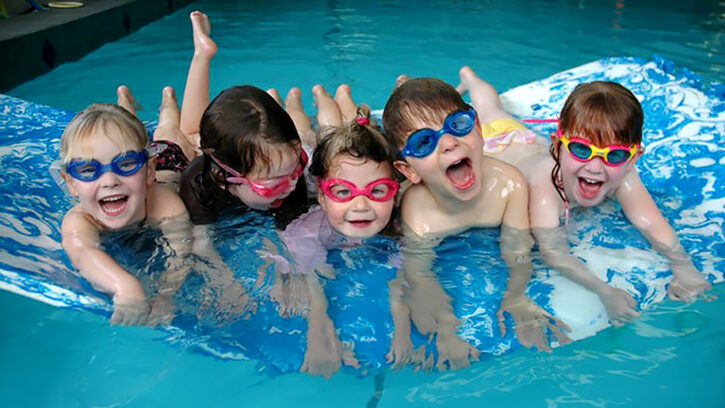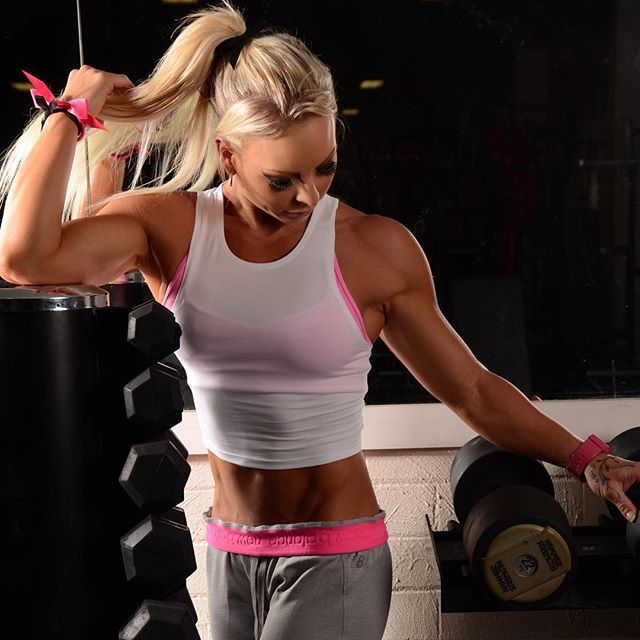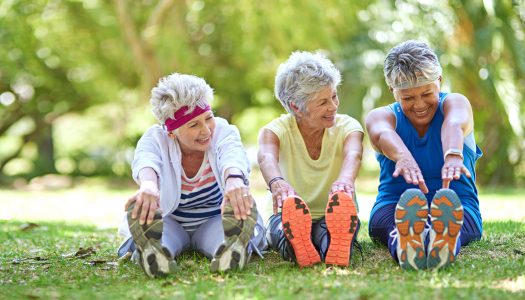What’s the Right Exercise for Your Age Group? The effect of exercise on health is profound. It can protect you from various conditions, including heart disease, type 2 diabetes, and some cancers. But the type and amount of exercise you should do changes as you age.
Accordingly, one of the keys to living a long and healthy life is staying active and exercising. However, for many people, by the time they get to age 50, they find that their body has declined — joints hurt, muscles are stiff, and they don’t have the stamina they did before.
Fortunately, there are things you can do right now to prevent those problems. You can look forward to many more years of all your favorite sports and activities. As an added benefit, by exercising and training as you age, you’ll make your “golden years” much more healthy and enjoyable.

Childhood and adolescence
In childhood, exercise helps control body weight, builds healthy bones, and promotes self-confidence and healthy sleep patterns. The government recommends that children should get at least one hour of exercise a day[1]. As a tip:
- Children should try various sports and develop skills, such as swimming and hitting and kicking a ball.
- Lots of non–scheduled physical activity is excellent, too, such as playing in playgrounds.
Exercise habits tend to decline during the teen years, particularly in girls, steadily. Getting enough exercise promotes a healthy body image and helps manage stress and anxiety[2]. You can also:
- Encourage teenagers to keep one team sport, if possible.
- For teenagers who are not into team sports, swimming or athletics can be an excellent way to keep fitness levels up.

What’s the Right Exercise for in your 20s?
In your 20s
You are at your absolute physical peak in your mid-20s, with the fastest reaction times and highest VO2 max – the maximum rate at which the body can pump oxygen to muscles. After this peak, your VO2 max decreases by up to 1% each year[3], and your reaction time slows each year[4]. The good news is that regular physical activity can slow this decline[5]. Building lean muscle mass and bone density at this age helps you retain them in later years.
- Varying your training will keep it fun. Try tag rugby, rowing, or boot camp.
- If you are a regular exerciser, get advice from an exercise professional to build “periodization” into your training regime. This involves dividing your training regime into progressive cycles that manipulate different training aspects – such as intensity, volume, and exercise type. Thus, optimizing your performance and ensure your peak for a planned exercise event, such as a triathlon.

What’s the Right Exercise for in your 30s?
In your 30s
As careers and family life for many intensify in their 30s, you must maintain cardiovascular fitness and strength. This will slow the normal physical decline. Therefore, if you have a sedentary job, make sure you maintain good posture. Also, break up long periods of sitting by forcing activity into your day. And, try moving around every half an hour where possible.
- Work smart. Try high-intensity interval training[6]. This is where bursts of high-intensity activity are broken up with periods of lower-intensity exercise. Thus, this kind of workout is right for the time-poor as it only takes 20 minutes.
- Especially after childbirth, all women do pelvic floor exercises; these are sometimes known as daily Kegel exercises to prevent incontinence[7].
- Diversify your exercise program to keep it interesting. For instance, try boot camp, spin class, or yoga.

What’s the Right Exercise for in your 40s?
In your 40s
Most people start to put on weight in their 40s. However, resistance exercise is the best way to optimize calorie burning. Moreover, it counteracts fat accumulation and reverses three to eight percent of muscle mass per decade. For example, ten weeks of resistance training[8] could increase lean weight by 1.4kg, increase resting metabolic rate by 7% and decrease fat weight by 1.8kg.
- Try kettlebells or start a weight-training program in your gym.
- If you don’t run already, take up running, and don’t be afraid to start a more intensive exercise program. Moreover, you’ll get more bang for your buck with running versus walking.
- Back pain often starts in this decade[9]. Pilates can be useful to build core strength.

What’s the Right Exercise for in your 50s?
In your 50s
In this decade, aches and pains and chronic conditions may crop up[10]. Such as type 2 diabetes and cardiovascular disease can manifest. And, as estrogen declines in postmenopausal women, the risk of heart disease[11] increases.
- Do strength training twice a week to maintain your muscle mass.
- Weight-bearing exercises, such as walking, is recommended. Walk fast enough so that your breathing rate increases, and you break a sweat.
- Try something different. Tai chi can be excellent for balance[12] and relaxation.

What’s the Right Exercise for in your 60s?
In your 60s
Typically, people accumulate more chronic conditions[13] as they get older, and aging is a significant risk factor for cancer[14]. Maintaining a high level of physical activity prevents cancers such as postmenopausal breast cancer, colon cancer, and womb cancer. And it reduces the risk of developing chronic conditions, such as heart disease and type 2 diabetes.
Physical activity tends to decline with age, so keep active and try to buck this trend.
- Try ballroom dancing or other forms of dancing; it’s a fun and friendly way to exercise.
- Incorporate strength and flexibility exercises twice a week. Also, aqua-aerobics can be a great way to develop strength using water as resistance.
- Maintain cardiovascular exercise, such as brisk walking.

What’s the Right Exercise for in your 70s?
The 70s and beyond
Exercise in your 70s and beyond helps prevent frailty[15] and falls [16], and it’s essential for your cognitive function[17]. Therefore, if you have a period of ill health, try to keep mobile, if possible. Strength and fitness decline rapidly[18] if you are bed-bound or very inactive. Thus, making it harder to get back to previous levels.
- Walk and talk. Instead of inactive visits from family and friends, go for a walk together. Besides, it keeps you motivated and boosts your health[19] more than solitary exercise.
- Also, incorporate some strength, balance, and cardiovascular exercise into your regime. But get advice from a physiotherapist or other exercise professional, especially if you have several chronic conditions.
What’s the Right Exercise for Your Age Group? Summary
As we age, our mobility and flexibility decline. Thus, we increase the risk of injuries and make it harder to do the activities we love. Therefore, to enjoy plenty of exercises — no matter your age — take the time now to improve the range-of-motion in your body.
Before every workout, do a dynamic warmup where you open your body and move properly. Moreover, take a few minutes to stretch to help your body stay loose and mobile on your off-days. Therefore, the main message is to keep moving throughout your life. Sustained exercise is what benefits health most.
I hope you found this article helpful and informative. If you have anything you’d like to share or any opinions about my website, please speak up. I look forward to your comments, questions, and the sharing of ideas.
Disclaimer: I am not a personal trainer or a healthcare professional. The guidelines above are what work best for me and might not be the right type of guidance for you. I always recommend consulting a doctor or health professional before making changes to your diet and/or fitness routine.
Related articles:
References:
- https://health.gov/sites/default/files/2019-09/Physical_Activity_Guidelines_2nd_edition.pdf#page=46
- https://www.sciencedirect.com/science/article/abs/pii/S1755296612000063
- https://www.ncbi.nlm.nih.gov/pmc/articles/PMC3794488/
- https://journals.plos.org/plosone/article?id=10.1371/journal.pone.0094215
- https://www.ncbi.nlm.nih.gov/pmc/articles/PMC3794488/
- https://theconversation.com/no-time-to-exercise-then-this-training-programme-might-be-for-you-62811
- https://onlinelibrary.wiley.com/doi/abs/10.1111/jmwh.12420
- https://pubmed.ncbi.nlm.nih.gov/22777332/
- https://www.ncbi.nlm.nih.gov/pmc/articles/PMC4612559/
- https://www.ncbi.nlm.nih.gov/pmc/articles/PMC3340492/
- https://www.ncbi.nlm.nih.gov/pmc/articles/PMC2376508/
- https://insights.ovid.com/pubmed?pmid=15692325
- https://www.sciencedirect.com/science/article/pii/S0140673612602402?via%3Dihub
- https://immunityageing.biomedcentral.com/articles/10.1186/s12979-017-0112-5
- https://pubmed.ncbi.nlm.nih.gov/30176345/
- https://www.publish.csiro.au/NB/NB10056
- https://www.sciencedirect.com/science/article/pii/S1568163707000384?via%3Dihub
- https://jamanetwork.com/journals/jama/fullarticle/186838?utm_campaign=articlePDF&utm_medium=articlePDFlink&utm_source=articlePDF&utm_content=jamainternmed.2018.4869
- https://www.nia.nih.gov/about/aging-strategic-directions-research/goal-behavioral-psychological-factors
Thank you so much for sharing with us a helpful and informative article. Our type of exercise changes from infancy to adulthood. The main reason for this is that the body changes, and a person’s needs become different. So, exercise must adapt with age. Otherwise, it will be useless to exercise. My personal opinion is that we will do what we need to do at that time or at that age to stay healthy.
I love this article. As a woman in my mid-20s, I can tell you that I love doing HIIT workouts and group boot-camp style training. I agree with your comment about variety because at the start of the pandemic, I was doing the same thing every day when my gym closed and I got so bored so quickly. But when I joined virtual classes, it helped me switch it up, and also my muscles thanked me for working out more thoroughly!
That’s great! I’m glad you found virtual classes. It’s always more fun to work out with others. Plus, it’s a motivation for improving.
All the best
Robert